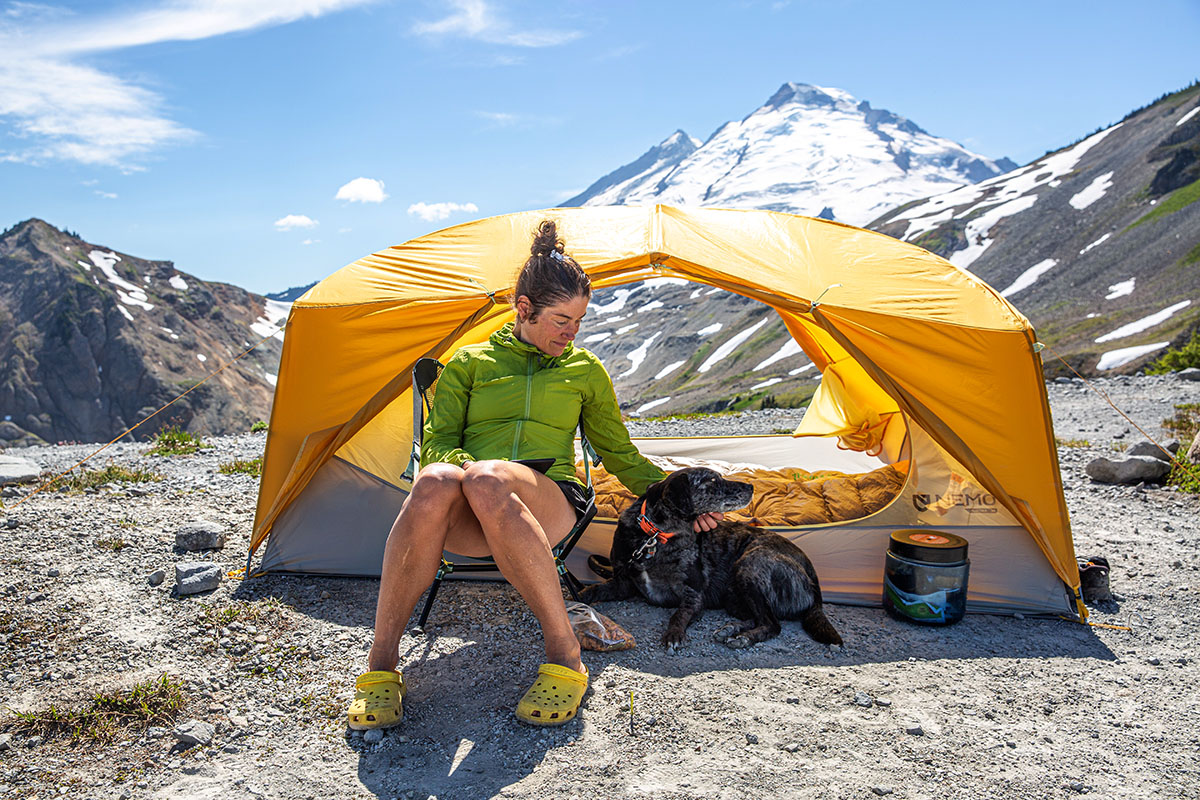
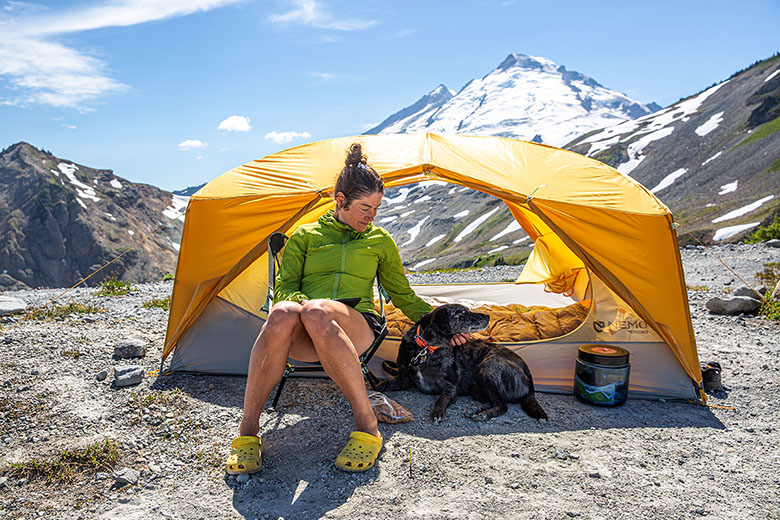
Price: $360
Packaged weight: 6 lb. 14 oz.
Floor area: 44.6 sq. ft.
Capacities: 2P, 3P
What we like: Spacious interior, durable materials, and crosses over well for car camping and short overnights into the backcountry.
What we don’t: Too heavy and bulky for use as a dedicated backpacking tent.
See the Nemo Aurora 3P
New Hampshire-based Nemo is a strong player in the premium backpacking tent space, but their Aurora takes aim at those looking to maximize livability without breaking the bank. Recently updated with more sustainable materials and a stronger pole design, the latest Aurora strikes a great balance between price and performance. It’s too heavy for long slogs into the backcountry (avid backpackers will want to look elsewhere), but we came away impressed by the tent’s spacious and high-end feel—great for those looking for one tent to take on car camping trips and short overnights. Below are our thoughts on the Aurora 3P. To see how it stacks up to the competition, check out our articles on the best backpacking tents, best budget backpacking tents, and best camping tents.
At a little under 7 pounds all in, the Nemo Aurora 3P won’t be mistaken for an ultralight backpacking tent. Instead, it’s best suited for folks who split their time between car camping and short overnights in the backcountry. We’ve also found it ideal for canoe trips when weight isn’t as much of a concern. For comparison, other hybrid designs aren’t too far off: The Marmot Tungsten 3P and Mountain Hardwear Mineral King 3 both check in at 7 pounds 1.2 ounces, while REI’s Half Dome SL3+ is over a pound lighter at 5 pounds 11.7 ounces. Smaller groups can opt for the two-person version of the Aurora (5 lb. 10 oz. all in), but my husband and I often camp with our dog, which necessitates the larger model (we also enjoy the extra space when we leave him at home). With the larger version, you could also leave the footprint behind, which will save you a substantial 10 ounces.
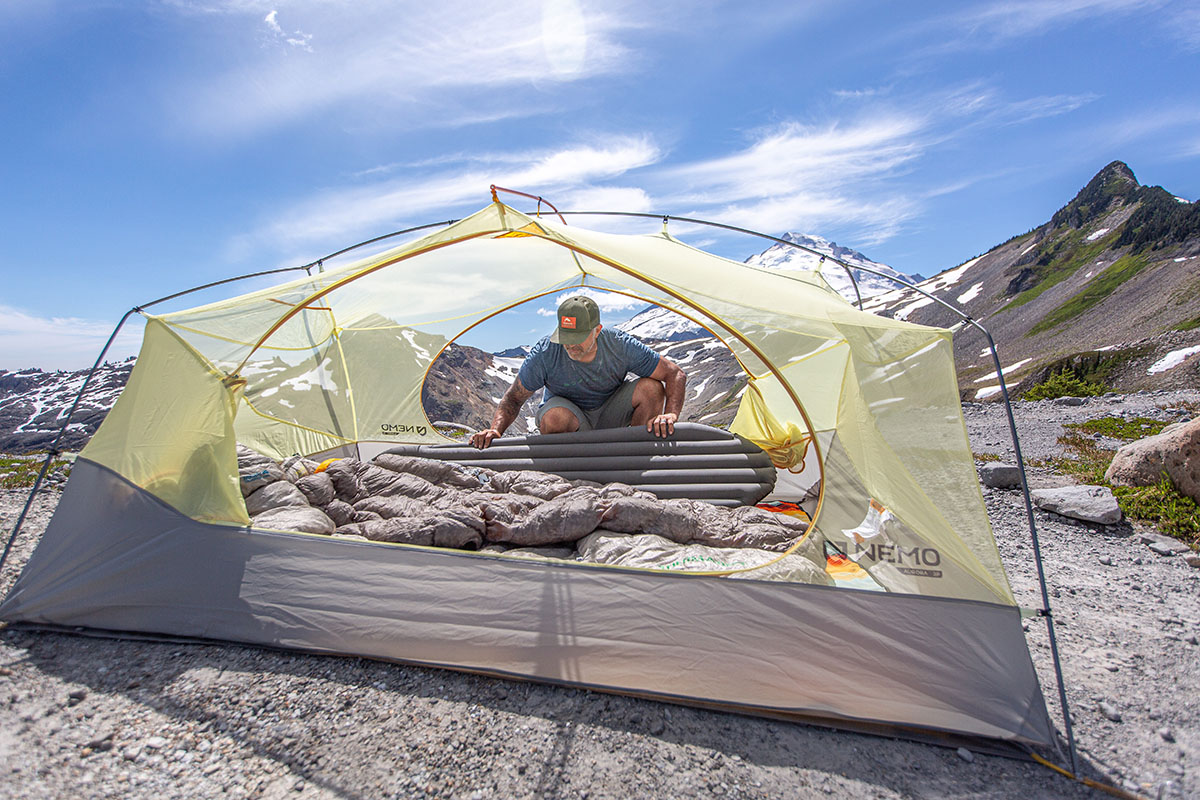
In terms of packability, the Aurora 3P stuffs down to 24 by 8 by 4 inches in its stuff sack, which boasts a roll-top closure for sealing out the elements and maximizing storage space (you can adjust the roll-top depending on which components you put inside). My husband sometimes reverts to stuffing the tent in the bottom of his pack and shoving other gear on top, which doesn’t give us too much cause for concern given the durable fabrics (more on this in “Build Quality and Durability” below). We also opted to divvy up the components on a trip into the Mount Baker backcountry: One of us took the poles and rainfly, while the other had the footprint and inner tent. With this setup, the Aurora 3P felt entirely manageable to carry for long distances.
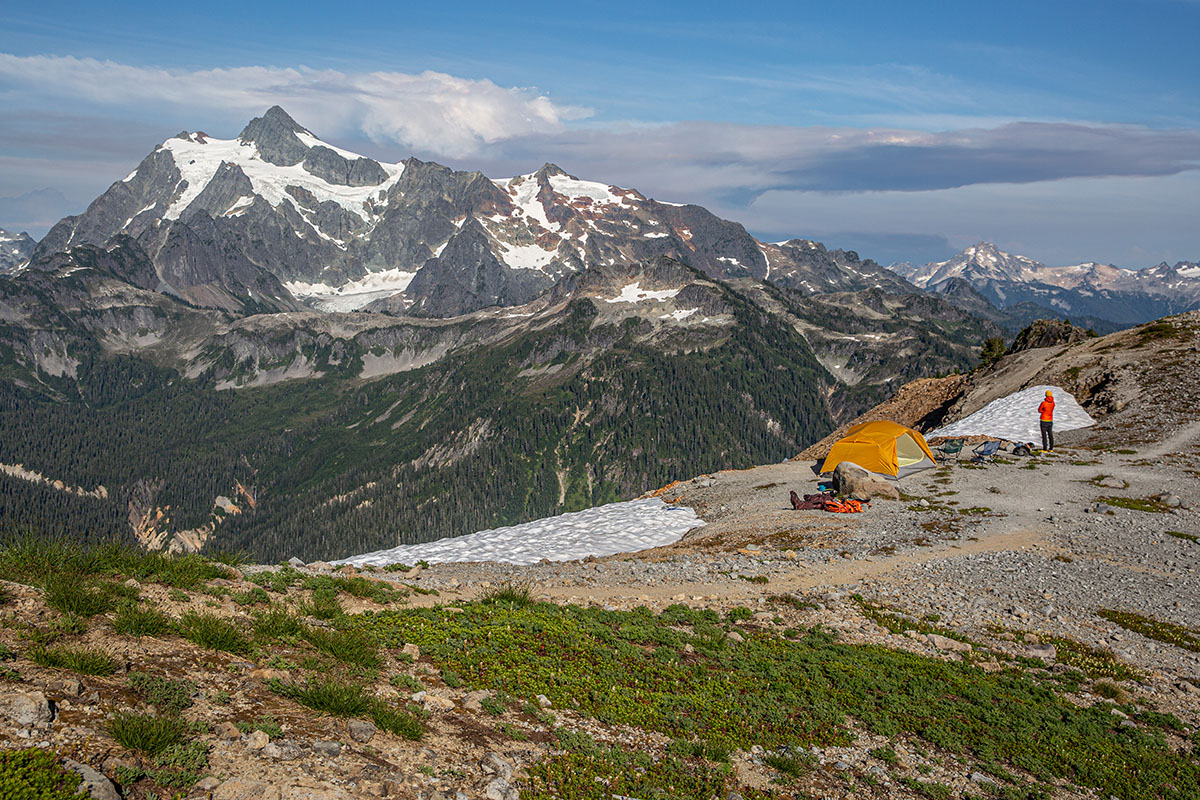
With 44.6 square feet of total floor space, the Aurora 3P was plenty roomy for two adults plus our large dog to sprawl out and organize gear. The 73-inch width was ample for fitting our double-wide (51.2-in.) sleeping pad plus a smaller pad for our dog, and the non-tapered build means you have the option of sleeping head-to-toe with your tentmate(s). The 44-inch peak height is also fairly generous—although not the tallest in the crossover space—and the tent’s steep walls create a very airy and spacious feel inside. Additionally, the tent features two large doors that make it easy to enter and exit without clambering over each other (and can be rolled back in fair weather), along with two generous vestibules for stashing gear, which I cover below. All together, these features make the Aurora 3P one of the few tents I’ve tested that feels like it can viably—and comfortably—sleep three (most designs feel a little compromised at full capacity).
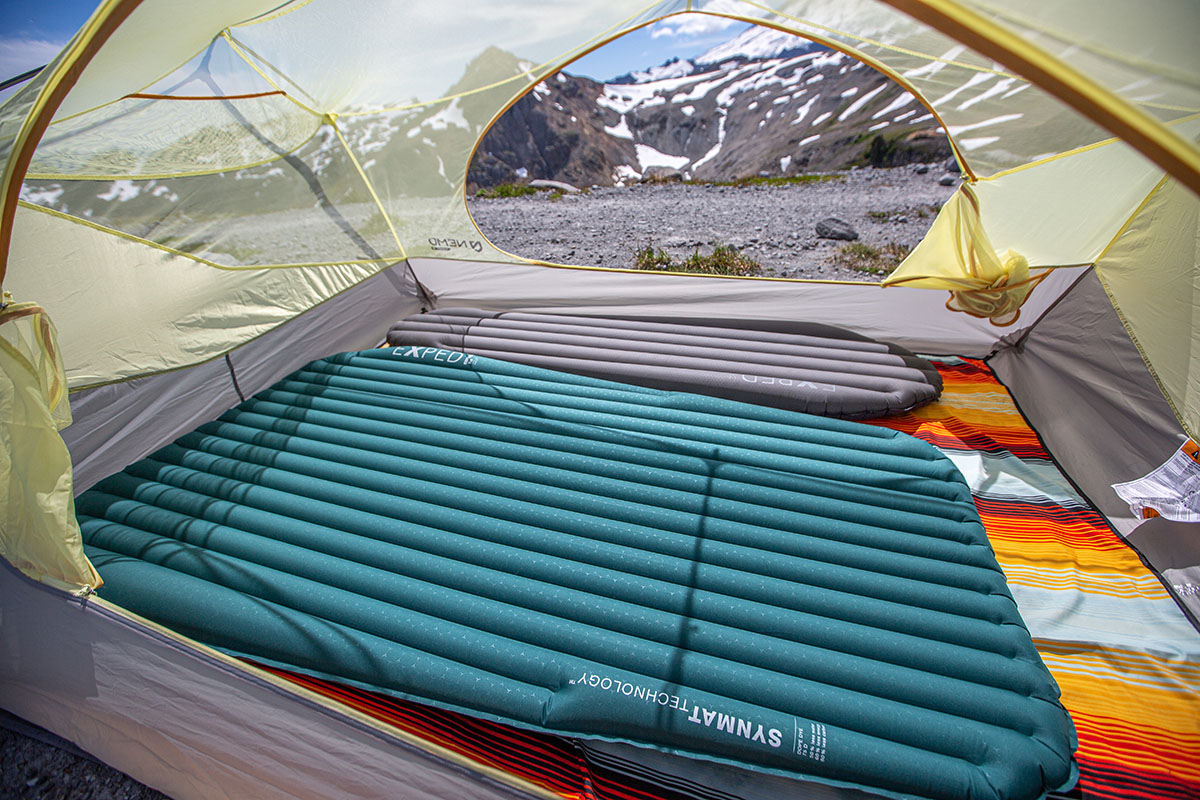
One advantage to crossover camping/backpacking tents is that they’re generally more durable than lightweight designs, and that holds true for the Aurora 3P. The tent body is made with a mix of 68-denier (D) polyester and mesh, while the floor and rainfly are a thicker, 75D polyurethane-coated polyester. Nemo also includes a quality footprint, which isn’t entirely necessary given the durable floor but will help maximize the tent’s lifespan (especially if you camp on rough surfaces often). In practice, the Aurora has held up incredibly well thus far: The poles are intact and haven’t been bent out of shape by strong winds, the zippers are running smoothly, all seams and stitches are free of loose threads, and the rainfly and floor continue to repel moisture. Impressively, the Aurora has also fended off tears and snags from our dog’s nails, which wasn’t the case with our much more fragile Big Agnes Copper Spur Platinum, which has a concerningly thin 7D fly and floor.
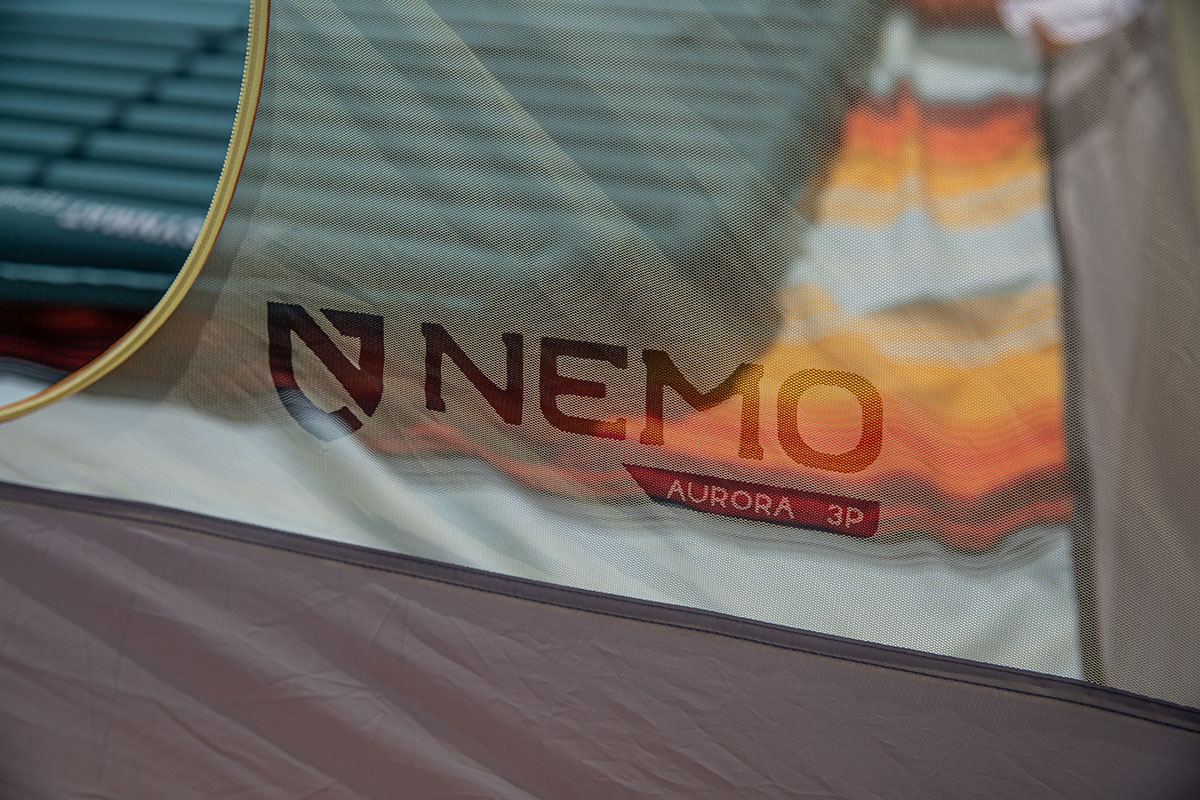
Like most tents, the Aurora’s biggest vulnerability is the mesh—and the tent has a lot of it. In our experience, the doors are particularly susceptible to damage due to their tendency to droop and get caught in the zipper teeth when getting in or out of the tent. Our original Aurora suffered a small tear as a result, although Nemo did tweak the design slightly with the newer model by adding another zipper slide/pull to each door. I still advise exercising caution when opening or closing the doors, but the double zippers make it easier to minimize excess fabric that could snag.
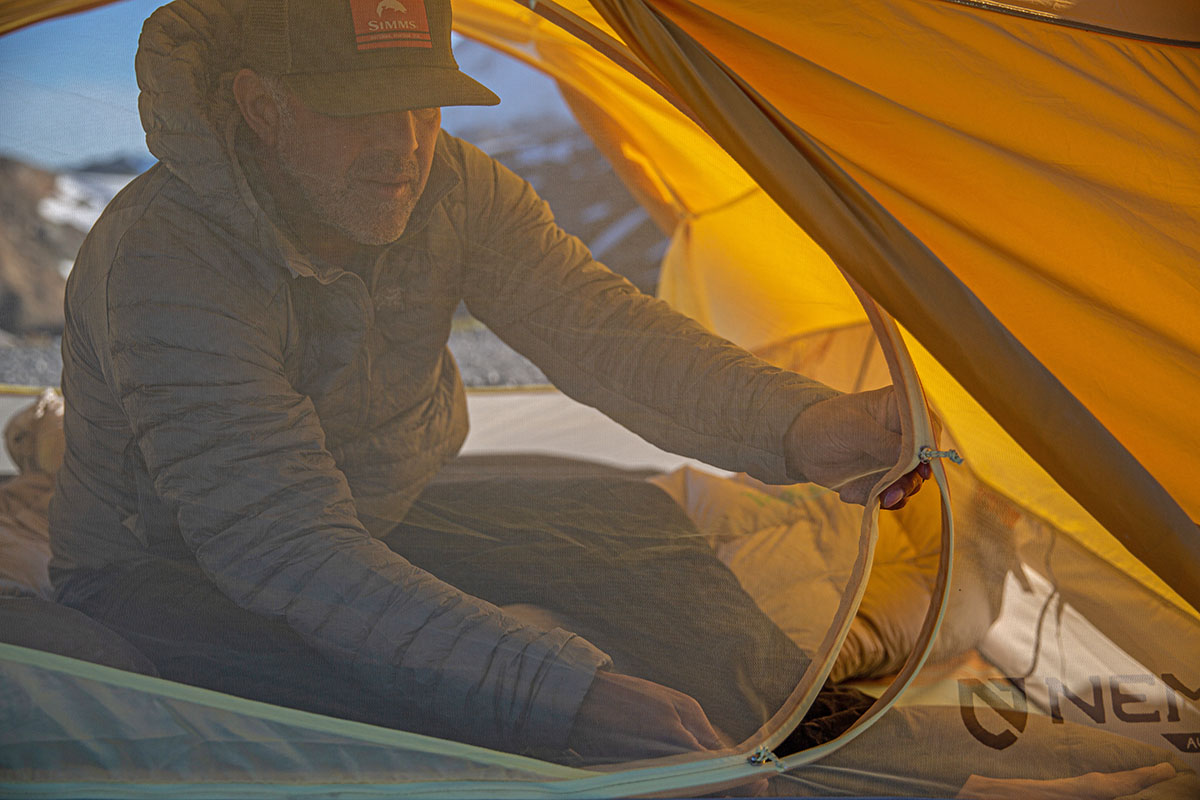
It’s worth noting that the previous generation of the Aurora came with Nemo’s “Pawprint,” which is a custom-fit blanket to protect the floor from dog claws and create a softer sleeping surface. The latest version doesn’t include the Pawprint, which we were disappointed to learn, but we were still able to utilize the insert from the past model. There are no snaps at the corners for securing it with the latest Aurora, but weighing it down with sleeping pads and bags effectively held it in place. To be sure, the floor feels thick enough that most folks shouldn’t have any issues when camping with a dog, but the Pawprint—or a thin camping blanket—can help maximize the tent’s lifespan.
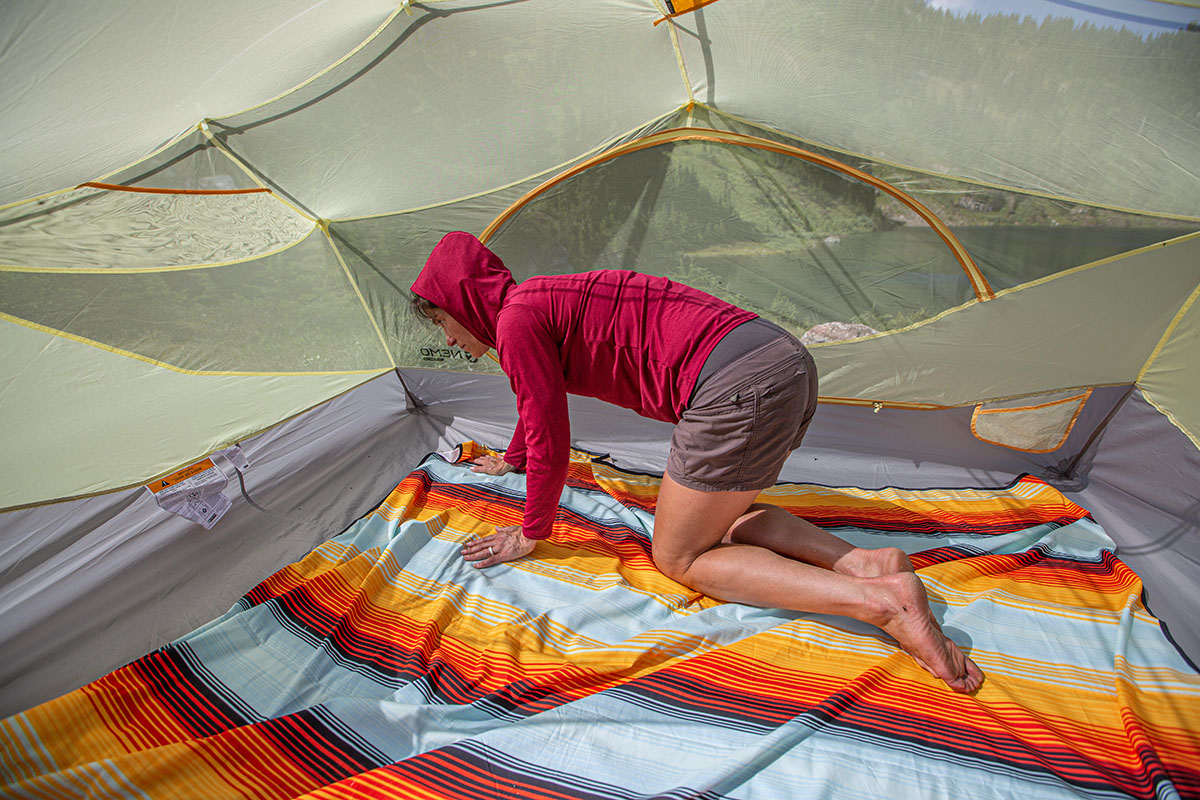
We found the past-generation Aurora to be very weather-worthy, and the latest model seems just as durable. We were especially impressed by the tent’s wind resistance: When pitched tautly, the Aurora is very secure, and the poles flex and bow as intended to combat strong gusts. Nemo also included four fabric loops and guylines for added assurance in particularly blustery conditions, and you can cut the lines or bring along more cord if you expect to utilize all the guy-out points. And a final nice touch: There are several Velcro loops on the underside of the rainfly that connect to the poles, which helps keep everything secure and reduce flapping in the wind.
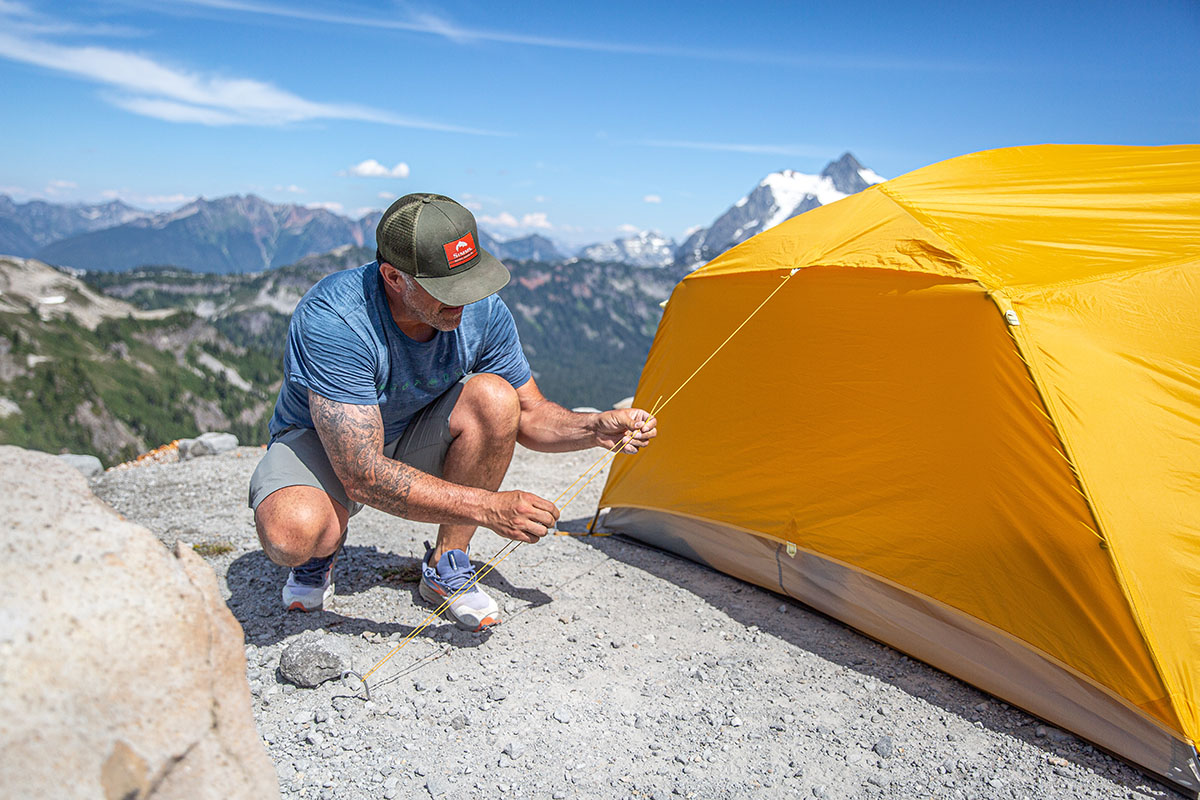
We haven’t experienced any torrential rain with the latest Aurora, but the prior model was a very strong performer, and all signs point to the new version being equally solid. Neither tent has allowed moisture in even during sustained exposure, and the addition of a second zipper slider on each door (the original Aurora had just one) makes it easier to enter and exit without allowing droplets (or insects) to creep in. There’s a chance that sideways rain could make its way in through the vents if they’re left open, and the rainfly leaves a little of the bathtub floor exposed to the elements, but we haven’t had any issues to date (and you can close the vents in truly rowdy weather).
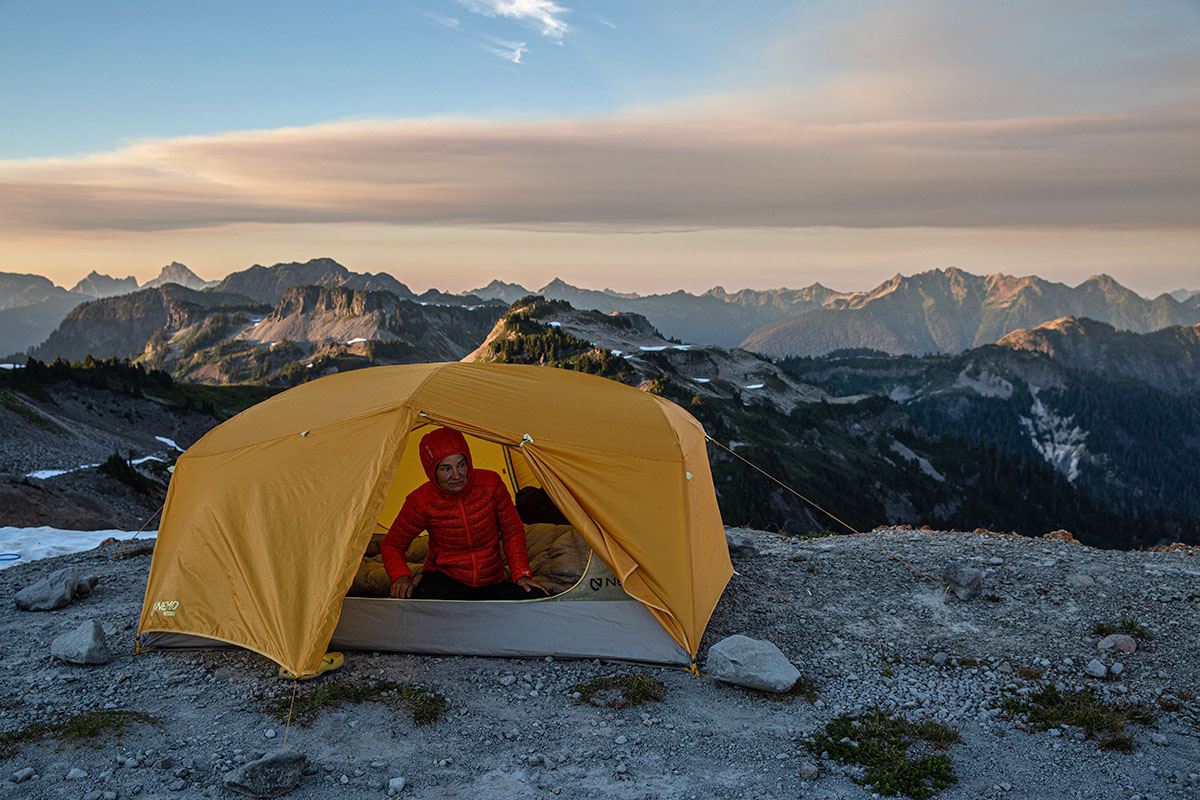
The Nemo Aurora 3P’s double-wall build and generous amount of mesh make it a great ventilator even in warm temperatures. The majority of the tent body is made of “No-see-um”-mesh—great for both airflow and stargazing—and Nemo also included two strutted vents in the rainfly (at the head and foot ends), which were very effective at increasing circulation and minimizing condensation buildup. We also found that guying out the lower portions of the sides allowed for better airflow underneath the fly. I’m not sure why Nemo opted to include diagonal sections of solid fabric on all sides—an all-mesh door would offer a little better ventilation—but the impact on breathability was minimal. Taken together, the tent kept us comfortable and condensation-free, even during a particularly hot, stuffy, and windless night while canoe camping.
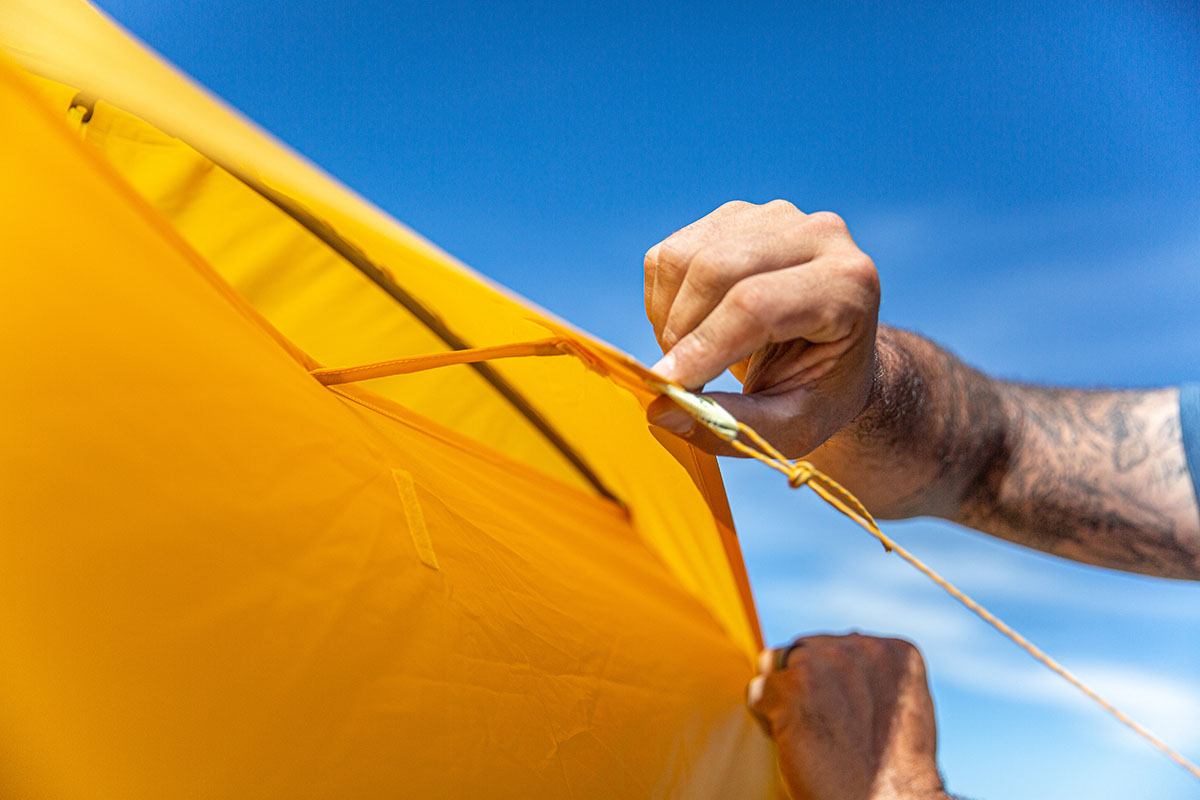
The Aurora 3P boasts two generously sized vestibules that measure 9.2 square feet each, which was ample for stashing our backpacks, hiking boots, and other gear that we didn’t need inside the tent with us. On the interior, Nemo included five total pockets: Two that run along the head and foot ends of the tent, two near the door that are designed to secure any excess fabric when the door is open (just stuff the fabric inside), and a fun “Nightlight” pocket overhead that can be used for storage or diffused illumination from your headlamp. All told, it’s an effective layout with plenty of spots to stash the essentials, and I love that the overhead and door pockets serve multiple purposes.
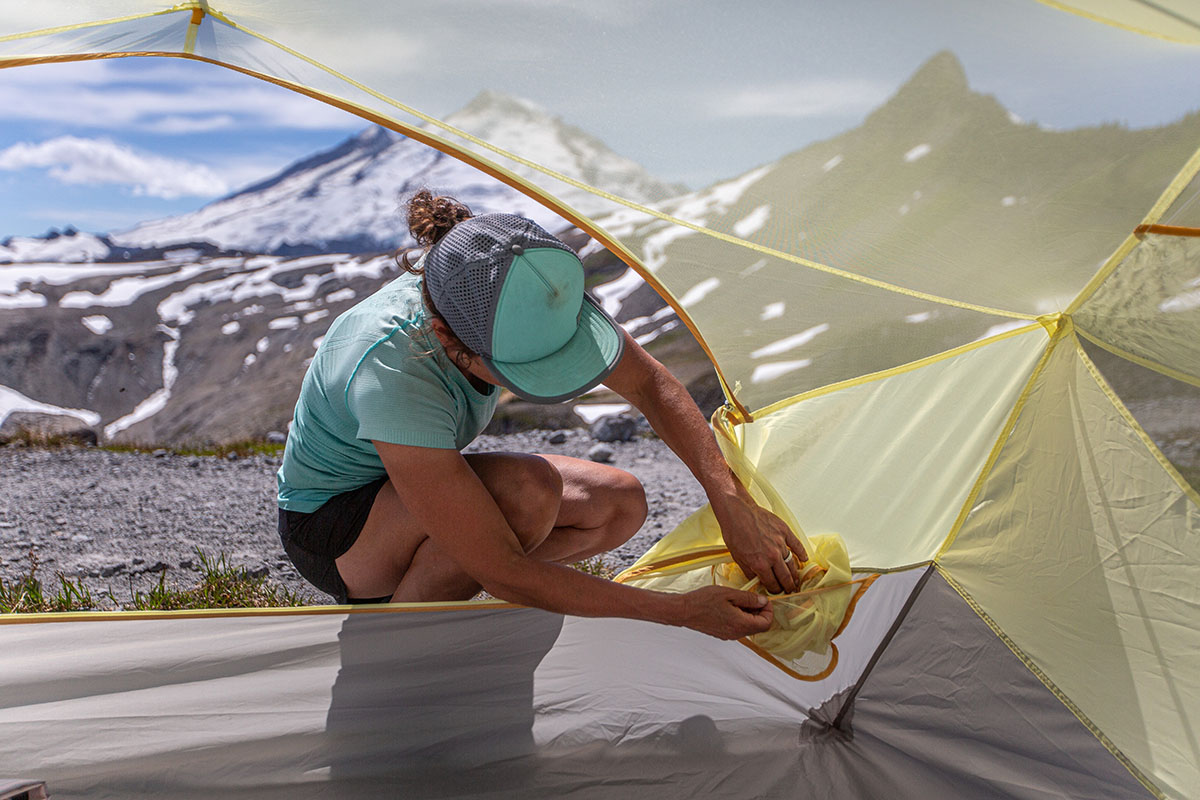
Symmetrical, freestanding tents are typically the quickest and easiest to set up, and the Nemo Aurora 3P is no exception. The tent has just two poles: a hubbed pole that splits into a “Y” at each end and a center ridge pole that runs perpendicular to maximize headroom. It’s worth noting that the ridge pole doesn’t attach to the main pole—it simply secures with grommets above each door—but we haven’t had any issues with stability in high winds or otherwise. Once the poles are secured to the corners and above the doors, setup is as simple as connecting each leg to the footprint and clipping the tent body to the poles. Since the tent is freestanding, staking it out isn’t required, although you do need to stake out the rainfly doors to keep them taut and create the vestibules. Nemo also includes four guylines for securing the tent in blustery weather.
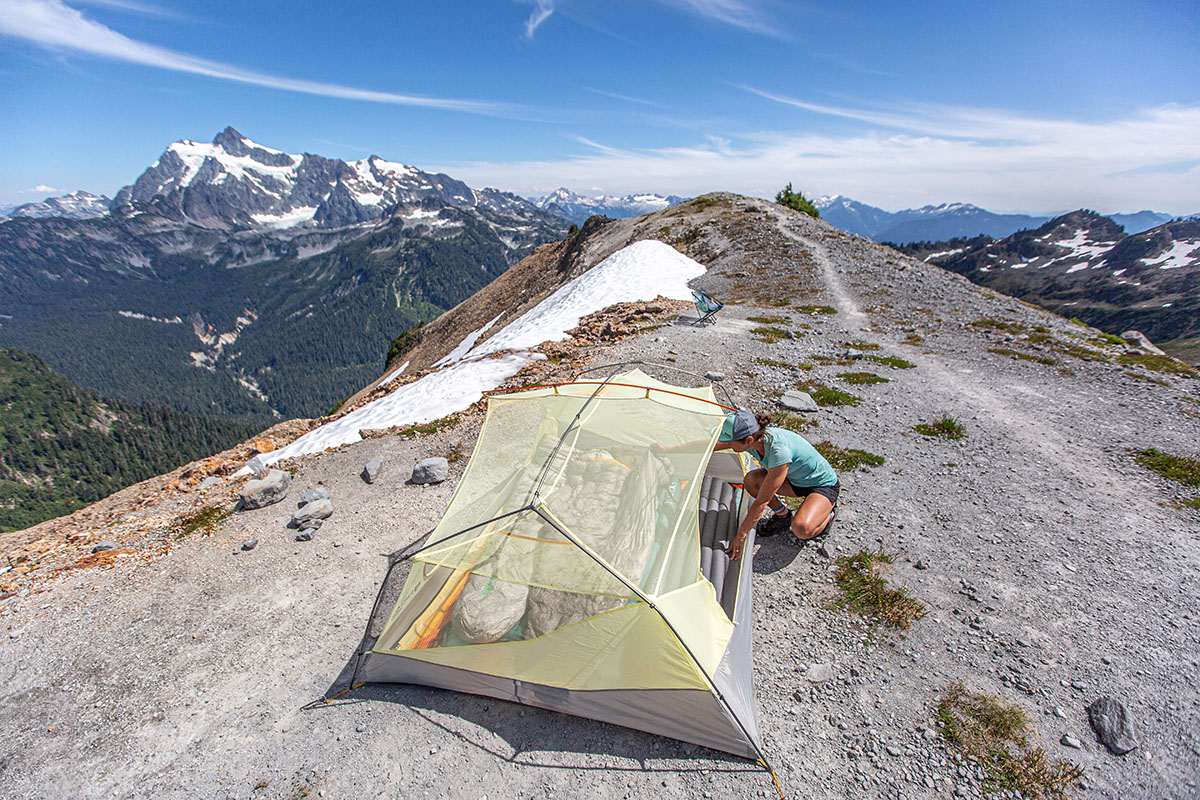
That said, there are a couple intricacies to keep in mind. First, you’ll want to connect the rainfly to the center ridge pole early on, as it can be difficult once the fly is taut (and it’s not intuitive to do this step first). Second, the grommets can be a little finicky, and we’ve had the poles pop out on more than one occasion. Nemo did improve the design by making the grommets slightly larger and angled with the latest Aurora, which improves security, although I’d still prefer more reliable quick-release buckles to secure the fly at the corners. But overall, the tent features a very quick and painless setup process—even for a solo camper.
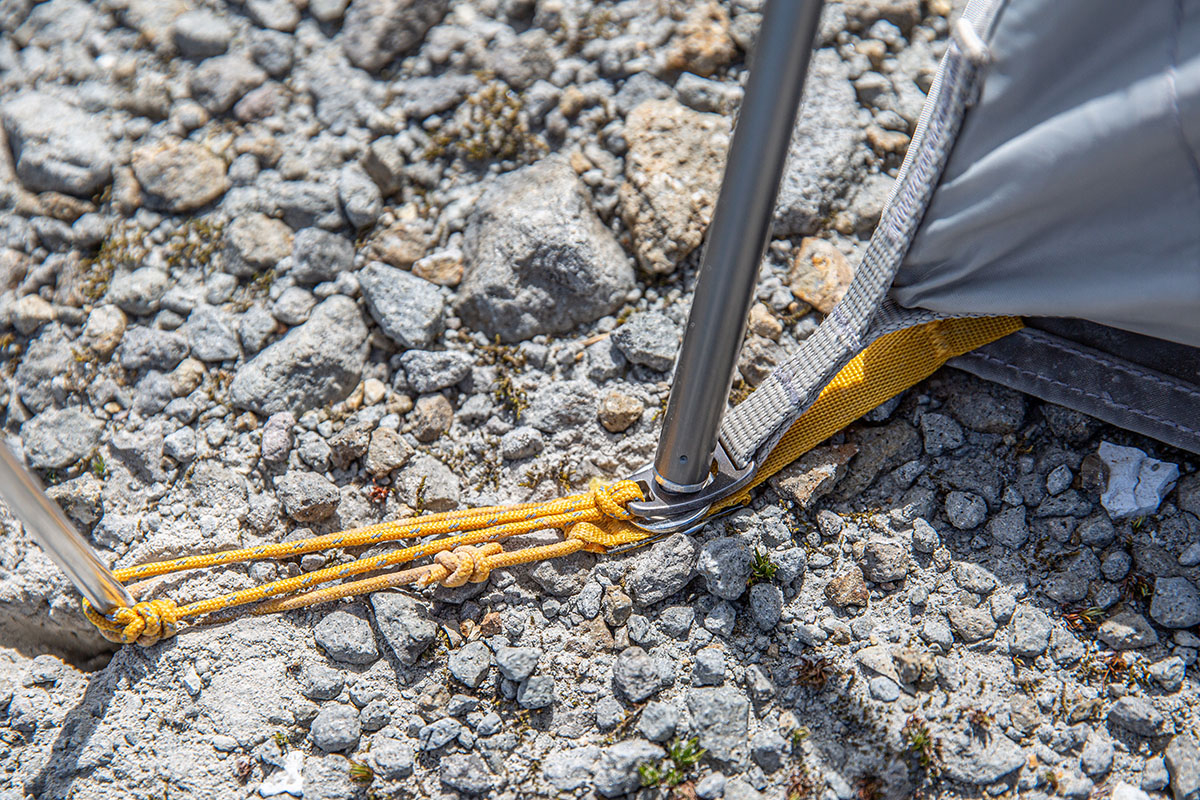
Nemo has made significant strides on the sustainability front in recent years, and the latest Aurora is a case in point. First and foremost, the tent is made with fabrics that are PFAS-free and feature a “fouling release coating,” or FRC. The former denotes per- or polyfluorinated chemicals that are known to be harmful to the environment, while the latter means the tents utilize a silicone-based, water-repellant finish that doesn’t release biocides or heavy metals into waterways. The Aurora’s floor is also made with recycled polyester that’s bluesign-approved, which means it’s undergone thorough testing and meets strict chemical safety standards. All told, we applaud Nemo for their ongoing sustainability push and appreciate their transparency about production and manufacturing processes.
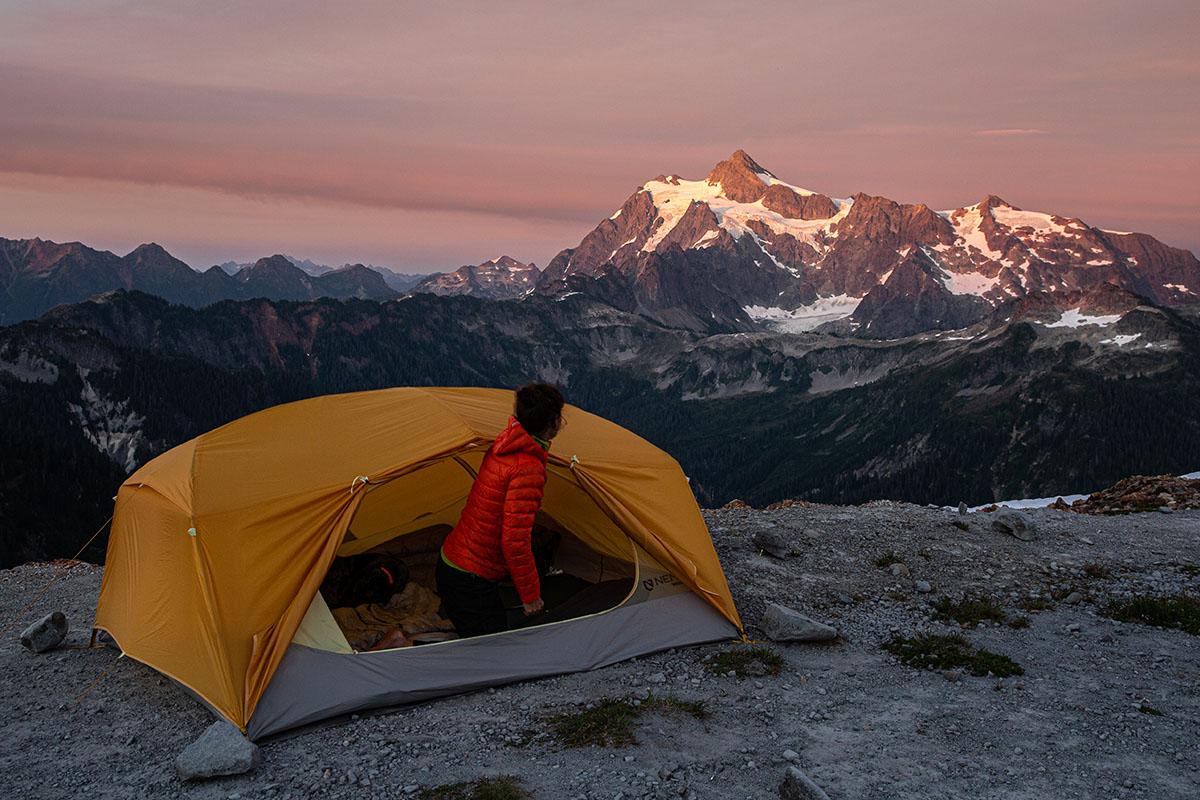
We tested the three-person version of the Aurora for this review, and Nemo also offers the tent in a two-person capacity for $300. In addition to saving you some cash, the Aurora 2P is considerably lighter at 5 pounds 10 ounces and packs down to 21.5 by 8 by 4 inches. It also retains the same length (88 in.), height (44 in.), and vestibule (18 total sq. ft.) dimensions, although width decreases by 20 inches. For car campers looking to maximize livability, Nemo also offers the Aurora Highrise, which is a standing-height design that comes in four- and six-person capacities ($400 and $500 respectively). In testing, we found the Aurora Highrise 6P to be an excellent all-around performer that’s spacious, easy to set up, and well-made with durable materials throughout (for more, see our in-depth review).
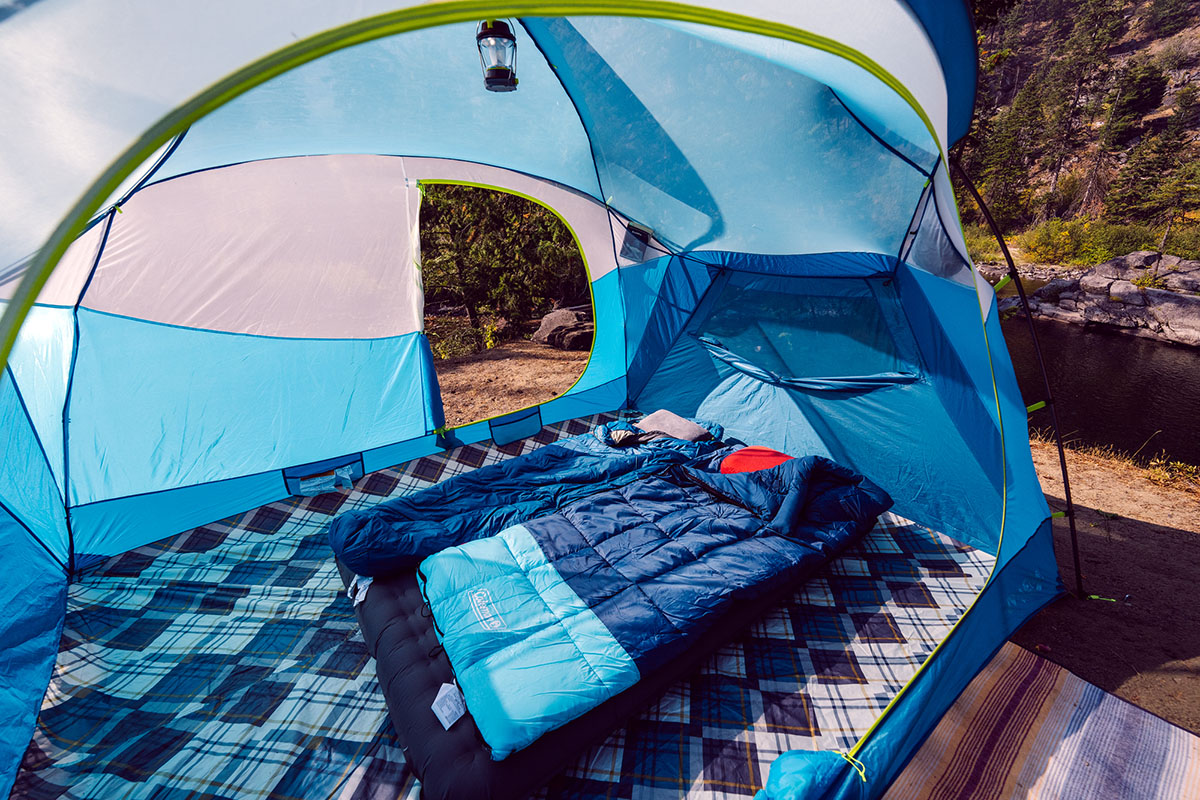
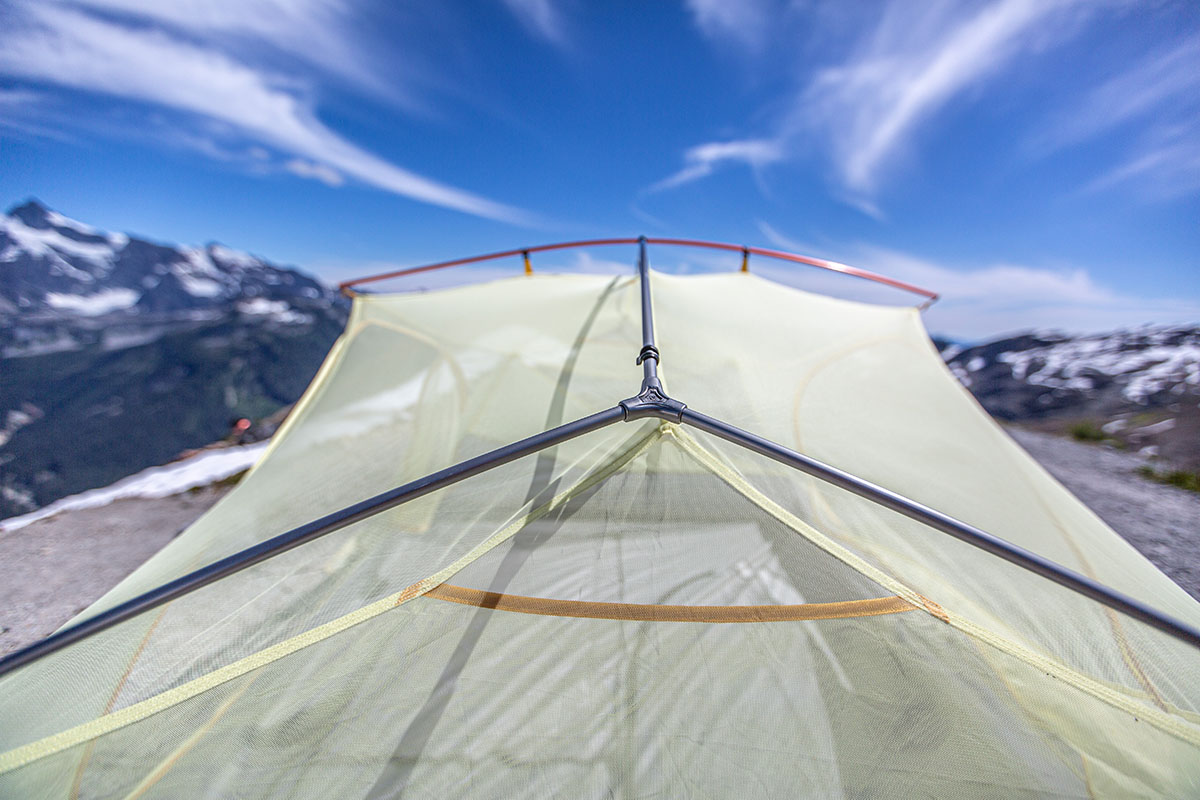
| Tent | Price | Weight | Floor | Area | Height | Door(s) | Capacities |
|---|---|---|---|---|---|---|---|
| Nemo Aurora 3P | $360 | 6 lb. 14 oz. | 75D | 44.6 sq. ft. | 44 in. | 2 | 2P, 3P |
| REI Co-op Half Dome SL 3+ | $399 | 5 lb. 11.7 oz. | 40D | 48.8 sq. ft. | 44 in. | 2 | 2+P, 3+P |
| Marmot Tungsten 3P | $299 | 7 lb. 1.2 oz. | Unavail. | 40.9 sq. ft. | 46.1 in. | 2 | 1P, 2P, 3P, 4P |
| Mtn Hardwear Mineral King 3 | $375 | 7 lb. 1.2 oz. | 68D | 42.5 sq. ft. | 48 in. | 2 | 2P, 3P |
| Nemo Dagger Osmo 3P | $600 | 4 lb. 10 oz. | Unavail. | 43.9 sq. ft. | 42 in. | 2 | 2P, 3P |
The Aurora 3P is a very competitive crossover design for those looking for a single tent for both camping and backpacking, but it’s not the lightest hybrid option available. For over a pound less, REI's Half Dome SL3+ boasts an even roomier interior with 48.8 square feet of floor space, along with larger vestibules (11.3 sq. ft. each). You also get ample mesh for stargazing and ventilation, a footprint for added assurance when camping on rough surfaces, and plenty of pockets and hang loops for stashing and securing gear inside. Like the Aurora, the Half Dome is symmetrical and freestanding, which makes it very quick and easy to set up. On the flip side, the Nemo will save you around $40, is a little more durable, and includes thoughtful touches like a Nightlight pocket and roll-top stuff sack (the Half Dome’s is a more basic drawcord-equipped bag). Both tents offer a hard-to-beat combination of price and performance, but we give the overall edge to the Half Dome for its more spacious interior at a lower weight.
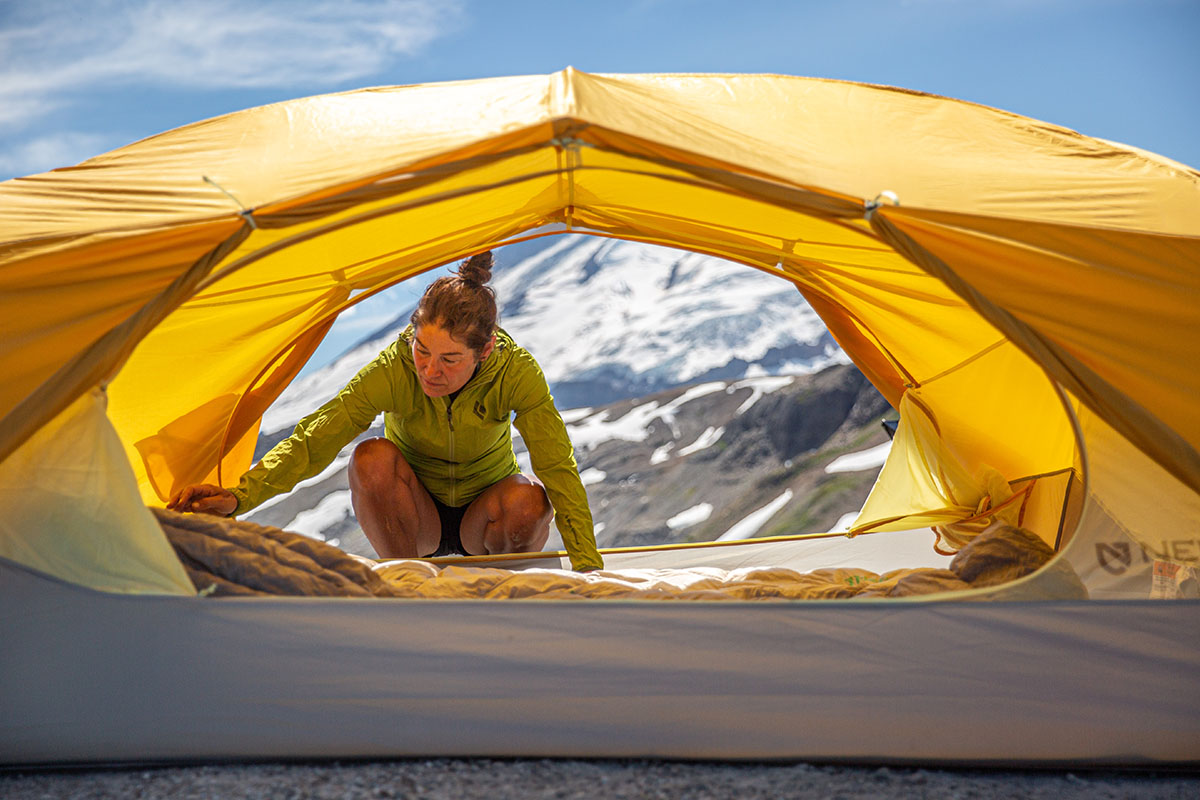
Another popular crossover design to consider is Marmot’s Tungsten 3P, which is around $60 cheaper than the Aurora at $299 (including a footprint). It’s also a little taller at 46.1 inches at the peak, has similarly large vestibules (9.2 sq. ft. each), uses comparably thick materials for the floor (70D) and fly (68D), and checks in around the same weight. The Nemo is a little more refined and wider than the Marmot by around 6 inches, but otherwise, the two stack up very closely in all-around performance. The Tungsten even includes niceties like a Lampshade pocket (similar to the Nemo’s Nightlight pocket) and color-coded components for easy setup.
A final hybrid backpacking/camping tent that we like is Mountain Hardwear’s Mineral King 3, which gives the Aurora a run for its money in a few areas. Both tents include footprints, offer ample interior organization (the Mineral King has five pockets), boast two large doors and vestibules with plenty of mesh to keep air moving, and are easy to pitch thanks to their symmetrical, freestanding designs. The Mountain Hardwear gets the edge in height by 4 inches and length by 2, but the Nemo is 5 inches wider and costs $15 less. In the end, if you’re looking to maximize space for the price, the Aurora is the slightly better option. But the Mineral King isn’t far behind, and taller campers may prefer the additional headroom.
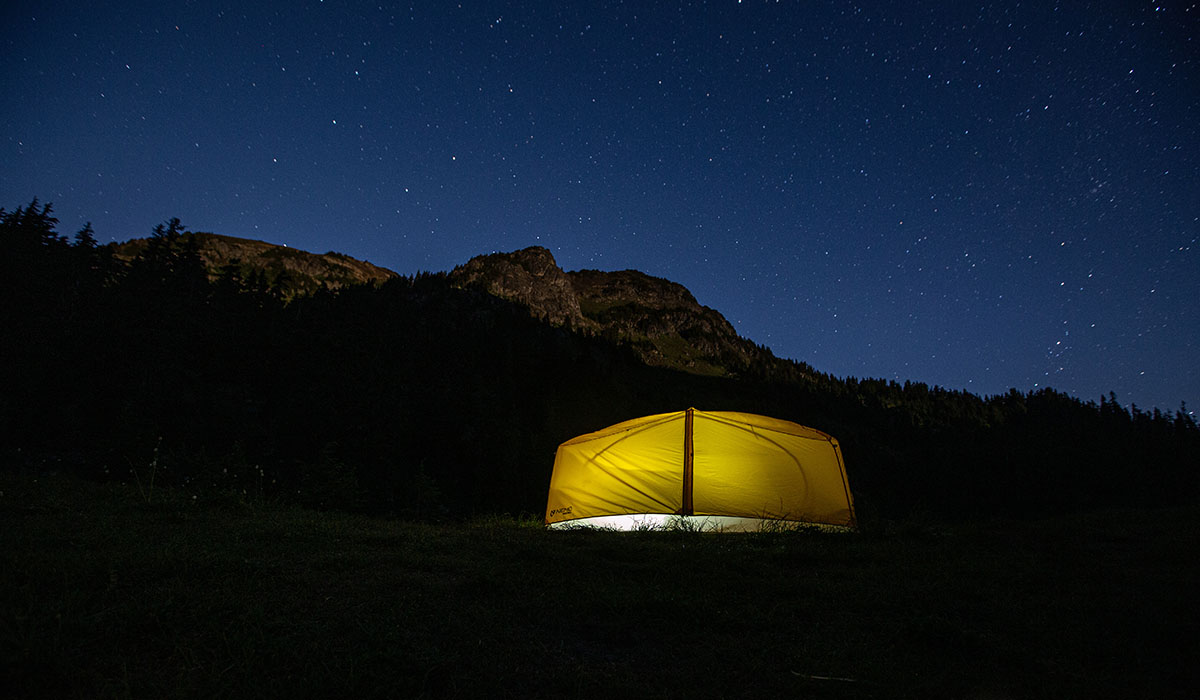
Last but not least is Nemo’s own Dagger Osmo 3P, which is the better match for avid backpackers willing to sacrifice some durability in the name of shaving weight. At 4 pounds 10 ounces all in and 19.5 by 6.5 by 3.5 inches when packed down, the Dagger is much more manageable to carry in a pack for long distances. Impressively, it’s still a very livable option with 43.9 square feet of floor area, two 11.4-square-foot vestibules, a 42-inch peak height, and plenty of interior storage. The biggest downsides are durability and cost: The Dagger is noticeably thinner than the Aurora (Nemo doesn’t provide a denier spec), doesn’t come with a footprint (you can purchase one separately for $80 or make your own), and costs a whopping $600, which is pricier than many similarly light competitors. But Nemo’s build quality is hard to beat, and the Dagger is minimally compromised for a lightweight backpacking tent.
Editor’s note: We usually provide a live price comparison table below our outdoor gear reviews, but the latest Aurora 3P is currently only available directly through Nemo. You can see the Aurora page here and support us in the process. Thanks!